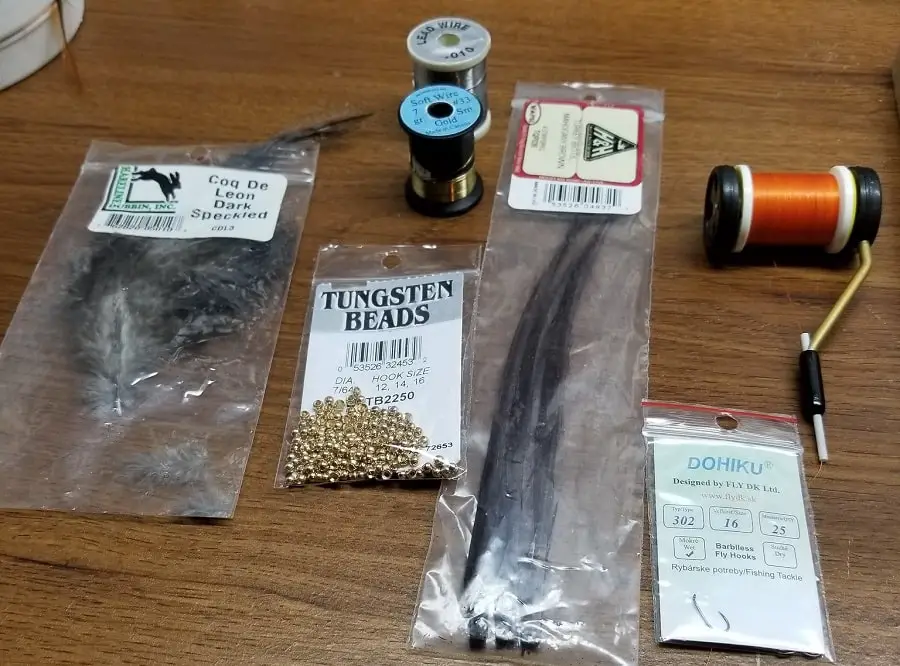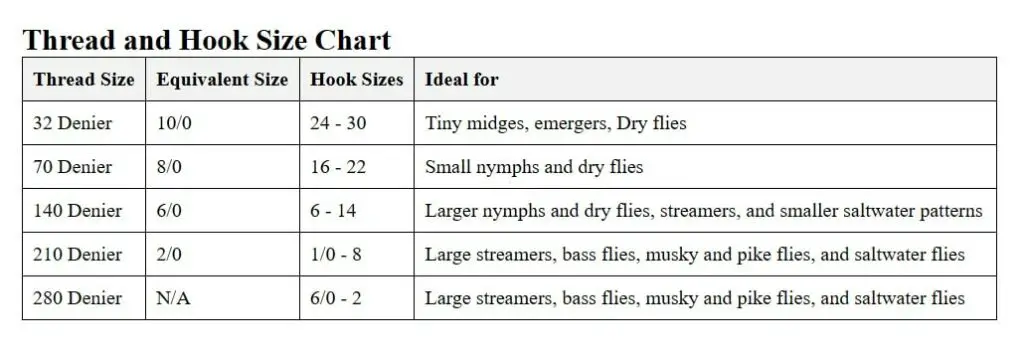Fly Tying Thread Sizes Explained: Easy Reference Table Included

You need the right size thread for the size of fly you are tying, and you need the right size and strength thread to secure your materials properly. This is where some fly tiers get a little confused.
But don’t worry; I’ve been tying flies for over 30 years, so I’ll keep it simple and explain fly tying thread sizes and which ones you need and don’t need.
I have belonged to a few fly-tying clubs with many new fly tiers, and I have also taught many anglers how to tie flies. One thing I’ve noticed is that new fly tiers tie their flies very bulky with oversized heads. But if you look at the flies of experts, you will see they keep them thin, and they have small or proportionately sized heads.
This comes down to three things: choosing the right thread size and learning to tie flies with thinner threads. Also, learn to secure your materials with fewer wraps of the tread so you don’t create excessive bulk.
Guys, thin flies tend to catch more fish for multiple reasons.
Quick Fly Tying Thread Sizes Table
There are two things I consider when choosing the right size tying thread. The size of the fly (or actually the size of the fly hook) and the type of material I will be using to tie the fly.
I always tie flies with the thinnest thread possible to get the job done, but certain materials require a thicker thread. I’ll discuss this below.
This chart shows you the best fly-tying thread sizes based on the fly and hook size but not material size or type.

Other Things You Might Want To Know About Fly Tying Thread Sizes
For those of you who want to know all the details about fly-tying threads, below I will cover these other things in more detail.
- Modern vs. Old Threads
- Why Thread Size Matters
- Thread Size Rating Systems – How To Decipher
- Hook Size Vs Thread Size
- Fly Size – Thread Size Matters
- Material Type – Make it Secure
- Full Tying Thread Sizing Table
Pro Tip: There are three things I tell all fly tiers that want to get better and faster at tying flies. Use the right fly tying tools use the right fly tying hooks, and use the right type and size of tying thread. And if you are new to fly tying, get yourself one of the fly tying books I recommend.
Modern Thread Versus Old Thread Sizing
Silk originally served as the default thread of choice for tying flies. Most people used the same thread that doctors and surgeons used for silk surgical sutures to close cuts and wounds.
Silk thread was an imperfect choice that most fly-tyers used but it was still better than sewing thread, which is weaker with a compatible diameter.
Silk thread is easy to tie but easy to break and costly to buy, and it doesn’t take dying as well as modern thread. The reliance on silk thread changed in the early 1930s when dedicated fly-tying threads first became available. Instead of using the same silk thread, different thread sizes made it possible to choose fly-tying threads that fully suit your needs.
Modern fly-tying threads are smaller in diameter while still being stronger, and some are even more abrasion-resistant.
Why Fly-Tying Thread Sizes Matter
Fly-tying thread sizes are important when you need to choose a thread for different types of flies and different fly-tying materials.
Thinner and lighter fly-tying threads tend to be best for tying smaller flies, while thicker threads are better for larger flies, or for securing fly-tying materials that you really need to sinch down tight, such as when spinning deer hair to your flies.
I like to use a generally all-purpose size and then vary the sizes for special needs.
When I want something that’s especially thick and durable, I can choose a larger size or pick one of the much thinner and lighter threads for fine detailing work.
It all starts with choosing a thread, which requires using one or both common systems for rating fly-tying thread sizes. Here’s a quick look at how to go about choosing the best size of fly-tying thread for your needs.
Deciphering Thread Size
Mostly, there are two primary systems for rating thread size. Those are the aught system and the denier systems. Many producers of fly-tying threads list both on their spools. Almost all tying thread uses either the aught system or the denier system to rate their thread configuration and sizes.
A third system came into being in 1988 when the Wapsi Fly Company moved away from two commonly used ones and introduced UTC Ultra Thread. Wapsi created a system that is similar to the denier thread system for its UTC Ultra Thread in which a smaller number equals a lighter and thinner thread.
The Aught Rating System
The aught system for fly-tying thread sizes is all about the zeros and the number that precedes them. The number tells you how many zeros are in the thread size. So a 3/0 says there are three zeros in that size while a 10/0 has 10 zeros. The more zeros, the lighter and thinner the line. So the smaller the first number is, the thicker the fly-tying threads are.
For years, the 8/0, 6/0, and 3/0 aught system sizes were used by most fly tiers with the 6/0 thread used the most. Like many others, I use the 6/0 thread a lot because it is versatile, durable, and readily available at local fly shops. I go bigger for saltwater fly tying with much bigger hooks and smaller when I want to tie a very small fly.
The Denier System
The denier system is a more standardized system for fly-tying thread sizes and represents how many grams 9,000 meters of thread weight. The thread industry denier standard is fairly simple and easy to understand. Generally, the larger the number, the thicker and heavier the fly-tying thread.
For example, if your thread says 70 denier, then 9,000 meters of that thread would weigh 70 grams. If it says 140 denier, then 9,000 meters would weigh 140 grams. Because the 140 weighs twice as much, it would be about twice as thick as 70-denier fly-tying threads. The 70 denier would be better for lighter and smaller flies while the 140 denier would work better with beefier dry flies and other larger flies.
Which Size Is Best For Your Fly, The Material, And The Hook?
I like to take the guesswork out of choosing fly-tying thread by using a standardized system based on the hook size, fly size, and the type of material to be used. The system works for denier thread and aught thread systems alike.
Hook Size Vs Thread Size
It’s not always about the size of the fly. I’ve tied long tailed flies on very tiny hooks, and when using tiny hooks, I need small thread.
Hook sizes and the corresponding amount of hook shank determine how much room you have to add your thread and materials. A corresponding thread can make it easier to tie flies with a particular size of thread.
Consulting the chart below, we see a 32-denier thread or a 10/0 aught thread size is ideal for hook sizes 24 through 30. That’s at the smallest end of the spectrum. Looking at the largest hook sizes of 6/0 through 2, a 280 denier thread is the preferred thread size. Using the provided chart will help to take the mystery out of choosing among many tying threads and sizes.
Fly Size – Thread Size Matters
Fly-tyers will find it easier to tie smaller flies, like small nymphs and dry flies, by using 70-denier or 8/0 aught threads.
The 140-denier or 6/0 aught threads are better for larger nymphs, dry flies, and freshwater streamers.
The threads also work well with smaller saltwater patterns. You certainly can go bigger with your flies and thread size and pick the correct one as indicated on the chart below.
Material Type – Make it Secure
Some materials, like deer hair or elk hair, require sturdier threads to tie them securely and give them some durability. Even tying a thicker tail with something like Marabou, rabbit strip, or synthetic material requires you to pull harder to secure the material in place, and a smaller thinner thread will likely break.
You also have the option to go with a super-thread. Some new modern are very thin and incredibly strong. I tie a lot of my bulky streamer flies with these threads and you should consider them. See The Best Fly Tying Threads article.
For the most part, though, following the chart based on hook size and the types of flies you are tying will help you to tie better flies.
Denier Fly Tying Thread Sizing – Hook Range
- 70 Denier- Hook Sizes 14 – 32
- 140 Denier- Hook Sizes 6 – 14
- 210 Denier- Hook Sizes 1/0 – 8
- 280 Denier- Hook Sizes 6/0 – 2
- 3/0 Thread – Under size 6 hook
- 6/0 Thread Hook Sizes 6 – 16
- 8/0 Thread – Hook Sizes 14 – 22
- 10/0 Thread – Hook Sizes 20 – 32
Tying Thread Size Table
Thread and Hook Size Chart
| Thread Size | Equivalent Size | Hook Sizes | Ideal for |
|---|---|---|---|
| 32 Denier | 10/0 | 24 – 30 | Tiny midges, Tiny emergers, Tiny dry flies |
| 70 Denier | 8/0 | 16 – 22 | Small nymphs, Emergers and Dry flies |
| 140 Denier | 6/0 | 6 – 14 | Larger nymphs and Dry flies, Streamers, and smaller saltwater patterns |
| 210 Denier | 2/0 | 1/0 – 8 | Large streamers, Bass flies, Musky and Mike flies, and Saltwater flies |
| 280 Denier | N/A | 6/0 – 2 | Large streamers, Bass flies, Musky and Mike flies, and Saltwater flies |
Fly Tying Thread Sizes Q&A
If you have a question or comment about Fly Tying Thread Sizes, let us know in the comments section below.
Tight Lines
Graham

Great stuff for a newbie like me. Can you make those charts available as a downloadable pdf so I could print it and keep it handy? Thanks for the info.
JD
Hey John,
I’m in the middle of my busy guide season now. I’ll consider you request over the winter, in the mean time just keep checking back when you need a reminder.
Graham
Hi Graham,
Thanks for the helpful information about thread for tying flies. I am just starting to tie. I would like to get away from synthetic (plastic) because I am concerned about microplastics in the environment. Is silk thread the only non-plastic option? Do you recommend the same sizing as with synthetic thread? Do you have a supplier to suggest?
Hi Kim,
My go to thread for most flies in UNI-Thread. The impact on the environment is tiny compared to other things humans use. I do not have much intel on silk fly tying threads but maybe check out Ephemera Pure Fly Tying Silk.
Graham